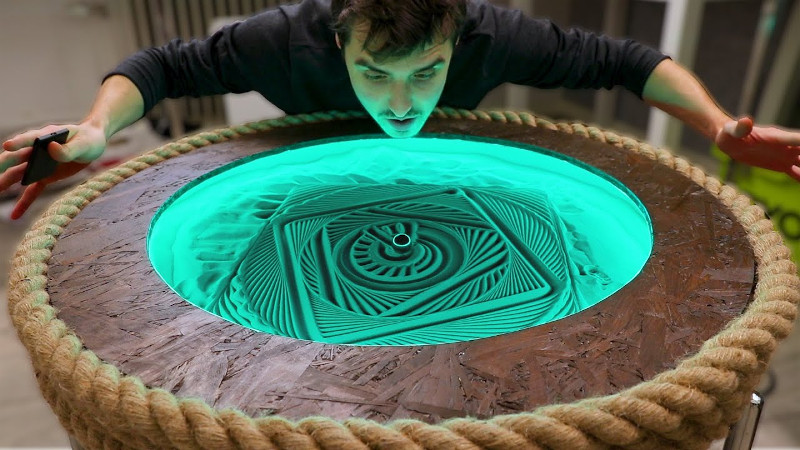Sand plotters are beautiful machines. They can make endless patterns, over and over again, only to wipe away their own creation with each new pass. Having seen the famous Sisyphus sand sculpture online, [Simon] decided to make his own.
The build came together quickly, thanks to [Simon]’s well-stocked workshop and experience with CNC motion platforms. The frame was built out of wood, with a combination of hand-cut and lasercut parts. After fabric-wrapping the outer rim turned out poorly, rope was substituted instead for a stylish, organic look. LEDs were installed inside to light the sand for attractive effect. The metal ball is moved through the sand via a magnet attached to an XY platform mounted on the back of the table. The platform is built out of old 3D printer parts, with a Creality CR10S Pro chosen for its ultra-quiet stepper drivers. Initial attempts to make the system near-silent were hung up by the crunching sound of the ball rolling over the sand; this was fixed by instead mounting the ball on a foam pad. While the ball is now dragged instead of rolling, the effect is one of blissful quiet instead of crunching aggravation.
The final build is incredibly attractive, and something we’d love to have as a coffee table as a conversation piece. We’ve seen [Simon]’s work around here before, too – with the water-walking RC car a particular highlight. Video after the break.
















This is so great. Might have to put some time in and make one of my own!
Now, you need the same thing with cocaine on top of the glass.
boring…highly enriched uranyl nitrate!
Wow! B^|)
And if you cared about stuff like this before, you think of v1engineering zenXY immediately, at least I did!
The V1 Engineering ZenXY was “Inspired by the awesome Sisyphus Table by Bruce Shapiro” just like this project. That quote is the first thing written on the ZenXY’s page.
Nice, I did something similar but had a case of feature creep, so it has a retractable magnet on the top, pen plotter on one side, and laser on the other. I can use it to move around board game pieces on the top and did a little self playing roguelike pirate ship game. I am horrible at writing any of my projects up though, so I should get round do doing that some day. I also had issues with the ball getting clogged in the sand, so the foam idea might be a good idea to try.
If the ball gets stuck, the bottom of the table is too thick, the magnet is too weak, or the sand is too deep. I have been working with these tables for about 2 years and tested all sorts of things and found that sand depth of 1/4 to 1/3 the ball diameter is best for detailed patterns and minimal problems with the ball getting buried. I use a 1″ cube N52 magnet and it keeps the ball moving even with a 1/2″ plywood bottom on the table and with acceleration of 20k mm/sec^2 and speeds up to 2k mm/sec (the limits of my testing, not failed).
If you want super quiet operation and high speed/acceleration, use servomotors! This video is real time, not time lapse:
https://www.youtube.com/watch?v=TfIEjEmIxBY
Oh nice, thanks! Yea I think its the magnet underneath that was my issue, as I needed to be able to retract it so that it wouldn’t move any of the other game pieces around, so I’m just using a little neodymium magnet underneath. I will have a play with a larger magnet and see how that goes. Which servos are you using for it?
https://www.aliexpress.com/item/32918424461.html driven by a Duet 2 WiFi controller. WiFi capability means I don’t have to have a control panel on the table. It can be programmed to run a specified series of patterns automatically at power-up.
Oh cool, thank you, I’ve never played with servos that size before. Yea I have a duet in one of my printers. Really nice board but pretty pricy. Looks to work great on your table, so I need to have a play with this setup.
Round table, square patterns, ocd triggered. ;-)
I’ve got a small tabletop one I built that runs klipper. It’s maybe 5″x5″ and a nice addition to my work desk.
Also use TMC drivers and it’s dead silent. No R2D2 noise.
any links to your klipper cfg?
I wonder if to erase everything quickly at once you could just attach an offset weight to a motor and vibrate everything to a level surface. Now I wanna build one but I most definitely would have nowhere to put it unless I make it fairly small. Too many projects, too little space/time/money
It would be extremely noisy, and wouldn’t solve the bigger problem of the sand eventually getting pushed toward the edges of the table. That requires manual intervention… for now…
Imagine this with a 3D camera and projector combination to display colour depth gradients instead of a solid colour fill.
Maybe add a depth camera and a projector.
WOOOOOOOOOOOW!!!
Never seen one of these before.
Was envisioning something to do with sand casting and making cores or even molds via a 3D printer with some sort of CO2 assisted water glass setting method or something for a rapid cure.
Looks cool though!
Pretty nice build, but the OSB board used for the top ring is hideous imho. Why not use a nice birch or hardwood plywood?
If I wanted to build a small tabletop version (about 10″x10″) with small budget, which would be best place to get parts?